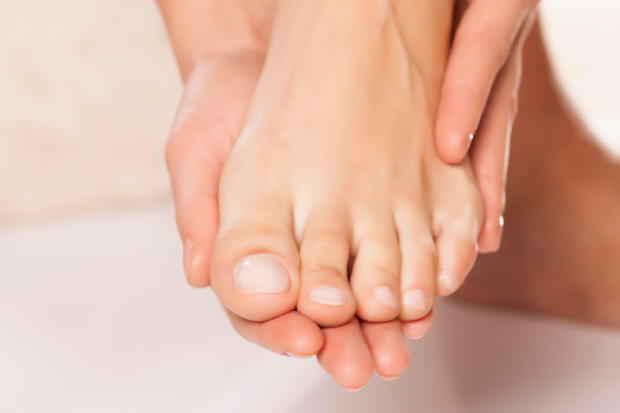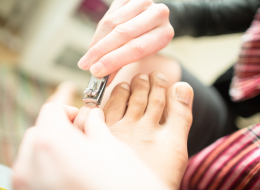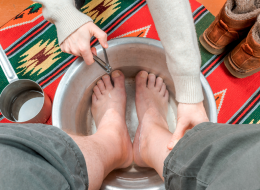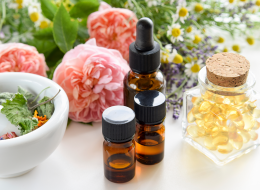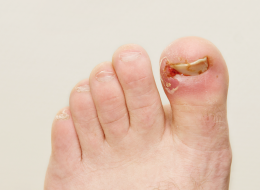Pain Relief Ingrown Toenail Treatment: Powerful Home Remedies For Instant Pain Relief
Ingrown toenail treatment is easier than you think. Just follow these simple steps for ingrown toenail removal and instant pain relief.
Like a weed in a beautiful garden, an ingrown toenail can pop up and wreak havoc on otherwise healthy feet. Luckily, there are easy ways to treat, heal and prevent ingrown nail issues, so read on for some home remedies guaranteed to bring you and your infected toe instant relief.
An ingrown toenail, medically referred to as onychocryptosis, is a painful condition in which the nail grows in a way that cuts into one or both sides of the nail bed. Since the disease is found only in shoe-wearing cultures, the general belief is that ingrown toenails are caused by the downward pressure created by footwear. However, many factors can contribute to ingrown nails, which are spelled out below. But first, find out if you really have an ingrown toenail by learning the common symptoms and then follow our ingrown toenail treatment methods that can help cure the condition and bring you quick pain relief.
Ingrown Toenail Treatment and Pain Relief
Symptoms and Signs of an Ingrown Toenail
As anyone who’s had an ingrown toenail will tell you, the condition can be excruciating. It starts with an inflammation of the paronychium (the nail bed surrounding the toe), followed by the toenail growing into the resulting nodule. This creates pain around the margins of the nail that is worsened by any pressure, including that from shoes and even from the light weight of a bed sheet. Accidentally hitting or bumping the ingrown nail can cause sharp pain, as the nail further pierces the skin tissue.
Considering the nature of ingrown toenails, the condition can easily become infected. Signs of an infection stemming from an ingrown toenail include redness and swelling, and/or pus and watery discharge leaking from the affected area. If these symptoms are present, it is important to contact your doctor, as untreated ingrown toenail infections can lead to abscess and even the loss of the toe.
Ingrown Toenail Treatment And Pain Relief
As mentioned above, if your ingrown toenail shows signs of infection — including swelling, redness and/or discharge — it is best to see your doctor rather than to try treating the problem yourself. In rare cases, surgical removal of the toenail or nail bracing is required. However, if caught early enough, ingrown toenails can easily be fixed and healed at home with a combination of these ingrown toenail remedies:
YOU MAY ALSO LIKE:
Make A Toenail “Lift” For Instant Relief From Pain
Before applying any topical remedy for pain and swelling, start by separating the ingrown toenail from your sensitive and irritated skin. This will releive some of the pressure and give your skin a head start in healing. Start out by first cleaning the affected area and then using one of the following two methods to create a lift for your toenail:
- Use a toothpick to gently push the edge of the nail away from the skin and then slip a small, rolled up piece of cotton between the nail and the skin to keep them separated.
- Use a Band-Aid to separate the nail and the skin. You can do this by sticking one end of the Band-Aid near the ingrown toe, wrapping the Band-Aid tightly behind the toe and attaching the other end of the Band-Aid to the front of the toe — essentially using the force of the Band-Aid to pull the nail and the skin apart.
You can also cut the ingrown nail so that it is no longer puncturing the skin, but podiatrists strongly advise against this method as improperly cutting the nail could lead to further problems, including chronic ingrown nail issues.
Warm Water Soak
Once you’ve successfully learned how to separated the ingrown nail from the skin, you can move on to topical remedies that speed up healing and relieve ingrown toenail pain. One of the most effective ingrown toenail treatments is to soak the affected foot in warm water for 15 minutes, three to four times per day. Soaking allows the feet to soften, which helps draw the toenail out from the skin and aids healing. Adding one cup of Epsom salt or 1/2 of a cup of hydrogen peroxide to the warm water bath may accelerate the healing time, quickening the entire process. Epsom salt further softens the skin, while hydrogen peroxide acts as a powerful disinfectant. Remember to once again separate the ingrown nail from the skin after soaking your foot.
Apple Cider Vinegar
Often referred to as one of nature’s wonder drugs, apple cider vinegar is a natural disinfectant that can be applied directly to the ingrown toenail. Use a cotton ball to apply the vinegar several times per day to accelerate healing of your irritated skin and ward off possible ingrown toenail infection.
Oregano Oil
This essential oil is thought to be antibacterial, antiseptic and palliative, which makes it a strong option in DIY ingrown toenail treatment. Mix a few drops of the oil with coconut oil, which is another natural antibiotic, and apply directly to the affected area several times daily. Oregano oil not only assists in healing, it can help alleviate ingrown toenail pain.
*Note: Do not use oregano oil during pregnancy. Do not give oregano oil to children under the age of five.
Vicks VapoRub
This menthol-based salve has been said to relieve ingrown toenail pain when applied directly to the affected area and covered with a small bandage. Vicks ointment also helps soften the skin, which encourages the ingrown nail to heal.
Tiger Balm
Similar to Vicks VapoRub, Tiger Balm is a healing salve that has helped many people in the treatment of ingrown toenails. The balm — made from menthol, clove bud oil, cassia oil and camphor — can be applied twice a day to promote ingrown toenail healing. Cover with a small bandage after application to keep the product from rubbing off.
While trying any of these ingrown toenail home remedies, it is important to wear comfortable shoes with open toes or wide toe boxes and to keep your feet thoroughly washed and dried. It is also helpful to keep your feet bare whenever possible. When this is done in conjunction with any of the above treatments, your ingrown toenail should be cured within a couple of weeks.
Causes of Ingrown Toenails
The number one cause of ingrown toenails is tight fitting or poorly fitting shoes. High heels are especially to blame, as they often squeeze the toes together into uncomfortable positions. The other leading cause of ingrown toenails is improperly cutting and trimming the nails too short or in a curved shape rather than straight across. However, other factors can lead to an ingrown toenail, including:
- Damaged nails
- Excessive sweating of the feet, which can cause the skin to swell and press into the toenail
- Diabetes, which causes many different foot issues
- Fungal and bacterial infections
- Vascular problems
- Abnormally shaped nailbeds
- Genetic susceptibility and other foot ailments
How to Prevent Ingrown Toenails
While there is no surefire way to prevent ingrown toenails from forming, there are a number of things you can do to decrease your chances of developing the pesky foot condition. They include:
- Wear properly fitting shoes and try to avoid frequently wearing high heels and other tight footwear that squeezes the toes together
- Walk barefoot without shoes and socks whenever possible, espeically when you're at home
- Properly cut your toenails straight across, never too short or in a curve shape
- Use caution when cutting or trimming your cuticles and surrounding nail skin (in fact, podiatrists recommend you never cut your cuticles)
- Keep your feet clean, dry and properly moisturized
- Visit your podiatrist at the first sign of foot and toe issues, as early treatment can often decrease your chances of developing chronic ingrown toenails and other foot problems
For more information about onychocryptosis, check out our complete Wiki section on ingrown toenails that includes detailed information on symptoms, causes, treatment and prevention.
Notice concerning medical entries:
Articles having medical content shall serve exclusively for the purpose of general information. Such articles are not suitable for any (self-) diagnosis and treatment of individual illnesses and medical indications. In particular, they cannot substitute for the examination, advice, or treatment by a licensed physician or pharmacist. No replies to any individual questions shall be effected through the articles.


